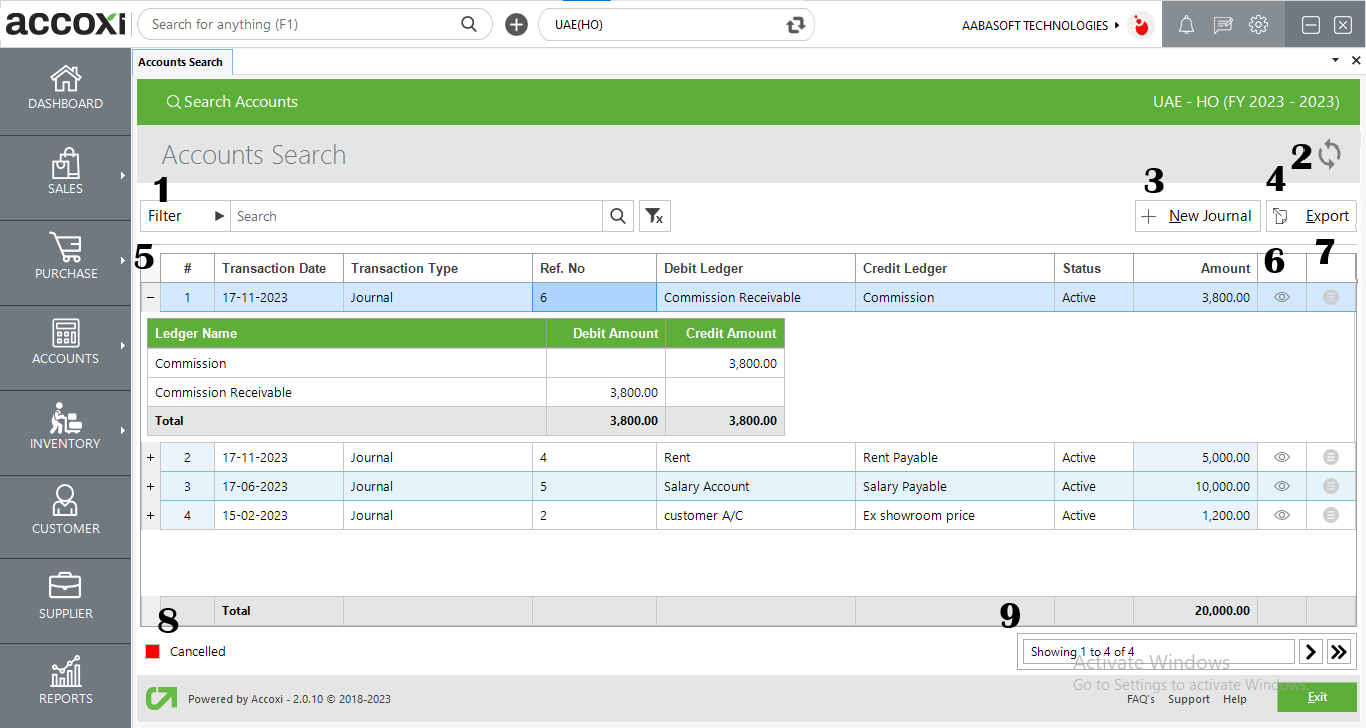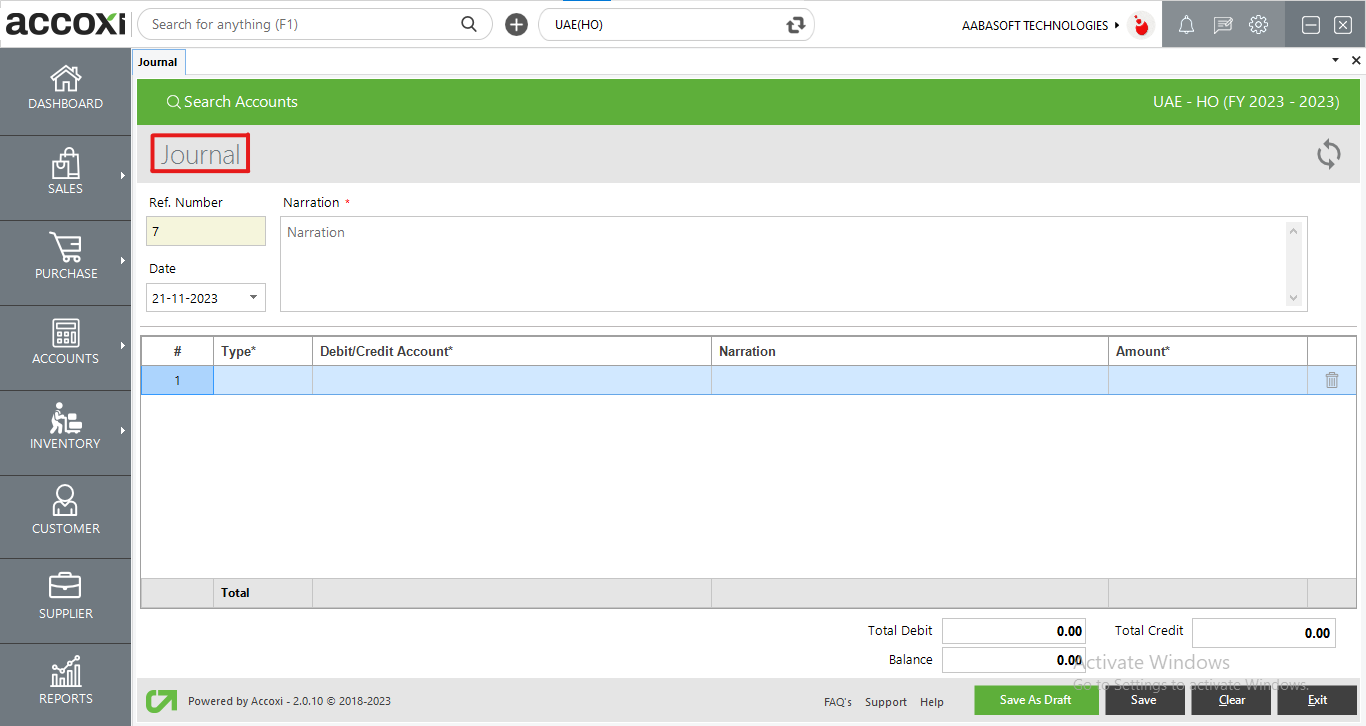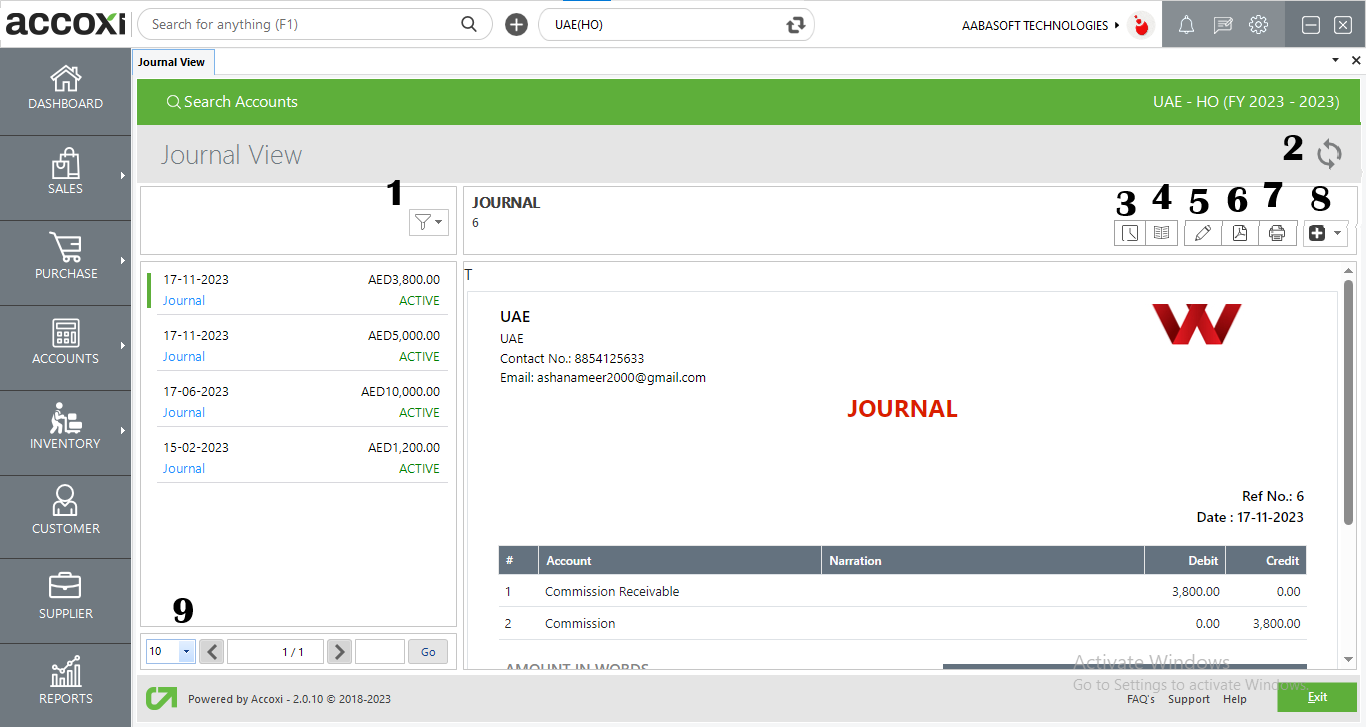
Navigating through the journal entry of Accoxi

A journal is a detailed account that records all the financial transactions of a business. It serves as a comprehensive record for future reconciliation and transfer to other official accounting records, such as the general ledger.
Key features:


Contents Available in Journal Search:
|
Field |
Description |
|
1. Filter |
The filtering of transactions can be accomplished in two ways: either by directly entering the transaction type into the search bar near the filter option or by clicking the filter dropdown. Users have the flexibility to filter data by transaction type, ledger name, reference number, cancellation status, or date. If the transaction data is filtered using the date format, users need to enter the starting date and the end date of the transactions. Transaction types available for filtering include sales invoices, purchase invoices, bills, debit notes, credit notes, etc. |
|
2. Refresh |
If the most recent data is not visible, simply click on the refresh icon located at the top-left corner of the page to retrieve the latest information. |
|
3. +New Journal |
The +New Journal option allows users to create a new journal, directing them to the journal creation window. |
|
4. Export |
To export the journal list to an Excel format, click the Export button located at the top-right corner near the +New Journal button. Choose the file location and click on Save. |
|
5. Ledger View |
You can view the journal in ledger format, displaying the ledger accounts present in the transaction. |
|
6. View |
The View menu allows the user to view the journal invoice that has already been created. |
|
7. More Options |
This menu includes an edit function. If the user wants to edit the created form, it can be done by using this menu. After clicking the edit option, the invoice form will appear on the screen. |
|
8. Cancelled Journal |
Cancelled journals are displayed in red. |
|
9. Pagination Control |
It manages page navigation and size in the journal section. Users can set the page size to 10, 20, 50, or 100. By entering the page number in the box and clicking on the Go button, it navigates to the specified page. |
To create a new journal entry, follow these steps:

|
Field |
Description |
|
Ref. Number |
The ACCOXI automatically generates a reference number for easy identification of journal entries. |
|
Date |
The user can enter the date of the journal entry in the respective field. |
|
Narration |
The user can enter narration for the journal entry in this field. |
|
# |
This refers to the numerical order or sequence of items in a table. |
|
Type |
The user has the option to choose between a DEBIT or CREDIT type for the journal entry. |
|
Debit/Credit Account |
The user should input the Debit or Credit account, which encompasses all the ledgers created and accounts of suppliers and customers. |
|
Narration |
The user can then input narration corresponding to the account. |
|
Amount |
The user can enter the amount in the corresponding debit/credit columns, but the debit and credit aspects should be equal; otherwise, a validation message will pop up. |
|
Delete |
The delete option can be used to remove line entries. |
|
Amount In Words |
It displays the amount entered in words. |
|
Total Debit |
It indicates the total debit amount in the journal. |
|
Total Credit |
This column displays the total credit amount in the journal. |
|
Balance |
The difference between debit and credit is shown in this column. If the difference is in the debit aspect, it shows a (Dr.) balance, and if the difference is in the credit aspect, it shows a (Cr.) balance. The voucher cannot be saved if there is any imbalance. To save the voucher, the debit and credit sides should match. |
|
Save As Draft |
Users can save the journal as a draft for further alterations and can convert it to a voucher later. |
|
Save |
By clicking "Save," the journal entered by the user will be saved, and it will be visible in the Transaction menu. Users can track the journal using the reference number of the journal. |
|
Clear |
To clear the data entered in the journal window, this option can be used. |
|
Refresh |
If your latest data is not displayed, click on the refresh icon on the top left corner of the page to fetch the new data. |
|
Exit |
To close the journal window without saving, users can click the exit button. |

|
Field |
Description |
|
1. Filter |
To filter out the journal entries based on active, cancelled, and drafts, users can use the relevant options available in the filter menu. |
|
2. Refresh |
If the latest data is not displayed, users can click on the refresh icon located at the top left corner of the page to fetch the new data. |
|
3. History |
The history window provides users with details of edits and alterations made to the Journal Contra. It includes comments and a chronological record of changes, allowing users to input comments related to the journal entries. |
|
4. View journal |
The Journal View in the menu displays both debit and credit aspects of the amount for a transaction. |
|
5. Edit |
The Edit menu allows the user to edit or correct the details that have been entered in the transaction. |
|
6. Export To PDF |
If the user wants to convert the journal to PDF format, the Export to PDF option is available. After clicking Export to PDF, a Save As directory option will appear, and the user can choose the PDF file saving location. |
|
7. Print |
The Print menu helps the user to print the journal if required. After clicking the Print button, it will redirect to print options where the user can select the printer, number of copies to take, etc. |
|
8. More Features |
In the More Features option, users can cancel the payment. By clicking Cancel, a validation message will pop up. Then click "YES" to cancel the payment and click "NO" to cancel and close the option. |
|
9. Pagination Control |
This feature controls the page navigation and the page size. The page size can be set to 10, 20, 50, or 100. By entering the page number in the box and clicking the Go button, it jumps to the specified page. |